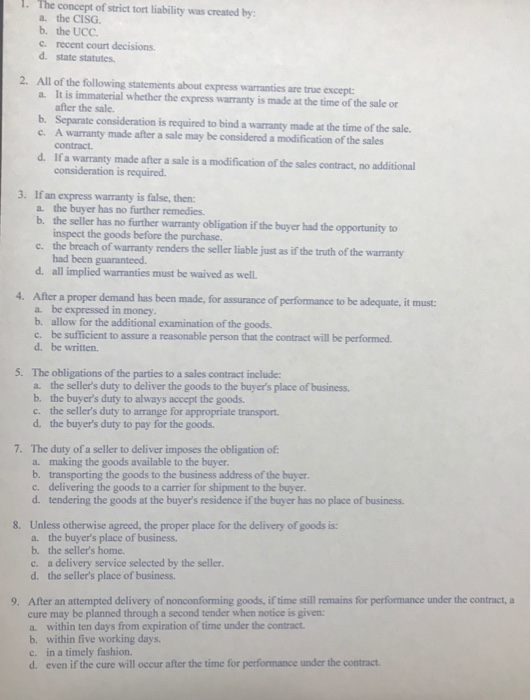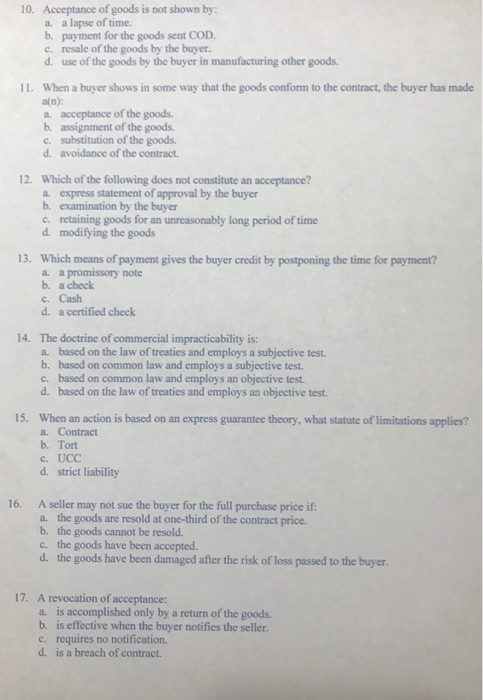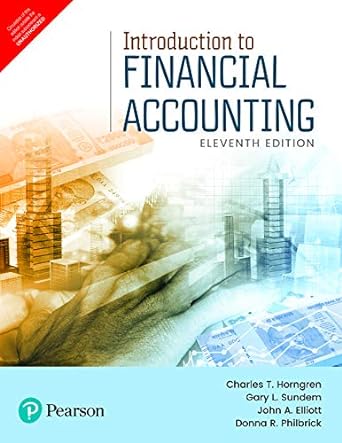1. The concept of strict tort liability was created by: a the CISG. b. the UCC c recent court decisions. d. state statutes 2. All of the following statements about express warranties are true except a. It is immaterial whether the express warranty is made at the time of the sale or after the sale. b. Separate consideration is required to bind a warranty made at the time of the sale. c. A warranty made after a sale may be considered a modification of the sales contract. d. If a warranty made after a sale is a modification of the sales contract, no additional consideration is required 3. If an express warranty is false, then: a the buyer has no further remedies b. the seller has no further warranty obligation if the buyer had the opportunity to inspect the goods before the purchase. c. the breach of warranty renders the seller liable just as if the truth of the warranty had been guaranteed. d. all implied warranties must be waived as well 4. After a proper demand has been made, for assurance of performance to be adequate, it must: a. be expressed in money. b. allow for the additional examination of the goods. c. be sufficient to assure a reasonable person that the contract will be performed. d. be written 5. The obligations of the parties to a sales contract include: a. the seller's duty to deliver the goods to the buyer's place of business b. the buyer's duty to always accept the goods. c. the seller's duty to arrange for appropriate transport. d. the buyer's duty to pay for the goods. 7. The duty of a seller to deliver imposes the obligation of a. making the goods available to the buyer. b. transporting the goods to the business address of the buyer. c. delivering the goods to a carrier for shipment to the buyer. d. tendering the goods at the buyer's residence if the buyer has no place of business. 8. Unless otherwise agreed, the proper place for the delivery of goods is: a. the buyer's place of business. b. the seller's home. c. a delivery service selected by the seller. d. the seller's place of business. 9. After an attempted delivery of nonconforming goods, if time still remains for performance under the contract, a cure may be planned through a second tender when notice is given: a. within ten days from expiration of time under the contract. b. within five working days. c. in a timely fashion. d. even if the cure will occur after the time for performance under the contract 10. Acceptance of goods is not shown by: a. a lapse of time. b. payment for the goods sent COD. c. resale of the goods by the buyer. d. use of the goods by the buyer in manufacturing other goods. 11. When a buyer shows in some way that the goods conform to the contract, the buyer has made an): a acceptance of the goods. b. assignment of the goods. c. substitution of the goods. d. avoidance of the contract. 12. Which of the following does not constitute an acceptance? a. express statement of approval by the buyer b. examination by the buyer C. retaining goods for an unreasonably long period of time d. modifying the goods 13. Which means of payment gives the buyer credit by postponing the time for payment? a. a promissory note b. a check c. Cash d. a certified check 14. The doctrine of commercial impracticability is: a. based on the law of treaties and employs a subjective test. b. based on common law and employs a subjective test. c. based on common law and employs an objective test. d. based on the law of treaties and employs an objective test. 15. When an action is based on an express guarantee theory, what statute of limitations applies? a. Contract b. Tort c. UCC d. strict liability 16. A seller may not sue the buyer for the full purchase price if: a. the goods are resold at one-third of the contract price. b. the goods cannot be resold. c. the goods have been accepted. d. the goods have been damaged after the risk of loss passed to the buyer. 17. A revocation of acceptance: a. is accomplished only by a return of the goods. b. is effective when the buyer notifies the seller. c. requires no notification. d. is a breach of contract








